August 2019 Update: Almost exactly a month after publishing this post, Google reps announced their site diversity update. I’ve updated this post to see if the diversity update had an impact on the examples used in my original post.
What is Google’s site diversity update?
Google’s diversity update aims to prevent a single site from dominating search results for most searches. Google said they are limiting the number of times a single site can appear in organic search results to at most 2 times.
Google SearchLiason (AKA Danny Sullivan) announced the update in a series of tweets on June 6th, 2019.
This site diversity change means that you usually won’t see more than two listings from the same site in our top results. However, we may still show more than two in cases where our systems determine it’s especially relevant to do so for a particular search….
— Google SearchLiaison (@searchliaison) June 6, 2019
Finally, the site diversity launch is separate from the June 2019 Core Update that began this week. These are two different, unconnected releases.
— Google SearchLiaison (@searchliaison) June 6, 2019
Google noted that the diversity update is unrelated to June’s core algorithm update. Since the diversity update and Google’s core algorithm update launched within a few days of each other, it’s a bit harder to analyze the impact each of the updates had.
Google’s Diversity Update Isn’t Perfect
Some users have pointed out that they’re still seeing a single site dominate SERP’s for unbranded queries.
It’s not going to be perfect. As with any of our releases, we’ll keep working to improve it. You might also try it the way someone in Tustin would do it — “nail salons” or “nail salons near me” or “nail salons tustin.” If you’re in Tustin, you know you’re in CA 🙂
— Danny Sullivan (@dannysullivan) June 6, 2019
I’ve added updates to each of my examples below to see what impact the diversity update had in SERP’s.
Since at least November (2018), I’ve noticed an interesting trend where Google returns multiple results for a (non-branded) query consecutively from the same website. Further, these results usually don’t appear to be unique enough to warrant multiple SERP placements.
I started noticing this when one of my new clients ranked back-to-back on page 2 for a highly competitive search term in the legal industry.
I wondered whether this was the result of keyword cannibalization.
However, after I did more research and created a strategy to de-optimize one of the pages – expecting that the primary page would move up – I continued to notice a similar pattern in Google SERPs.
I started to realize that this pattern wasn’t exclusive to sites/pages that weren’t high-ranking and that many sites were actually benefiting from this.
I’ve noticed an interesting trend in Google SERPs (Search Engine Result Page) since at least November 2018 where Google shows consecutive same-site organic results for the same query. This isn’t to say November is when it started, it’s when I started noticing it.
How long has this been going on?
Since Google’s “Medic” update (August 2018) there have been a number of Google algorithm updates that have shaken up Google SERPs.
As you’ll see in the examples below, Google is not only showing multiple results from the same website, results from the same website almost always show up consecutively.
Example 1: Black Friday Domination
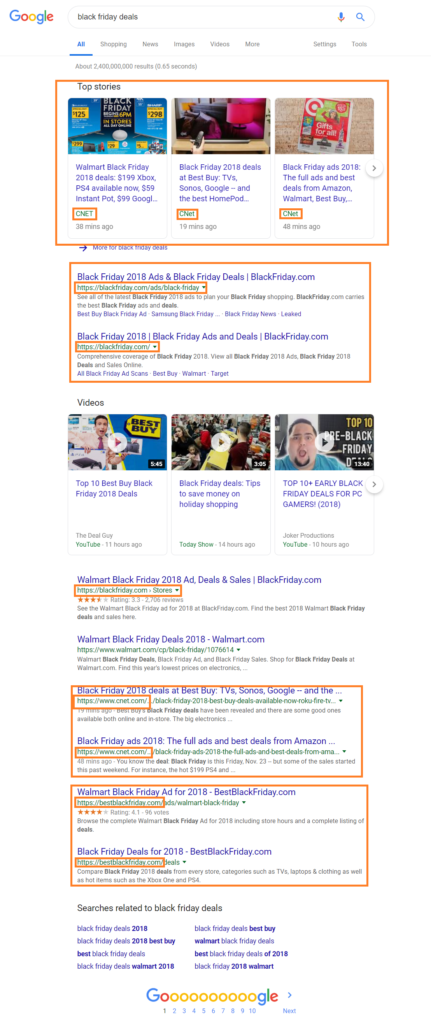
Notice, CNET takes up all 3 spots in Google’s Top Stories. I’m sure I’m not the only one to notice how sites like CNET seem to continually dominate Google’s Top Stories.
However, this may be (at least somewhat) unrelated to the topic of this article
CNET’s dominance may be explained by the fact that they continually add new articles and “update” existing articles to take advantage of Google’s love of freshness, especially via Top Stories.
To illustrate my point, in the screenshot above, all 3 articles were added within an hour of my search. Yet Black Friday ads are usually available weeks before the event.
This begs the question: Did CNET really wait until just a few hours before the big day to push content that could have been made public weeks beforehand?
From the user perspective, is this a good experience? I doubt it. The duplicative articles and updates often add information that was already publically available.

When we move down to organic results, the first 3 results are from blackfriday.com not to mention the first 2 results appear to have identical intent and messaging.
One is the homepage and the other is a navigational page that lists more options (including those already displayed on the homepage).
In short, sending users to either of these pages accomplishes the same goal. So why display both?
What happened to keyword cannibalization?
Two organic results from CNET appear further down the page, both of which are already included in Google’s Top Stories. If we exclude the video carousel, CNET has 5 of 11 results on Google’s first page.
Blackfriday.com claimed the top 3 organic results, CNET claimed the 3 top stories and 2 organic results, bestblackfriday.com claimed 2 organic results, and Walmart claimed 1 result for “Black Friday deals.”
Summing up, 4 websites took up all 11 results (excluding videos). This isn’t SEO wizardry; something’s up with Google’s algorithm.
Although this example is one of the strongest, it isn’t unique.
August 2019 Update
Since this example is based on a holiday it isn’t possible to fully analyze the impact of Google’s diversity update.
However, it looks like the diversity update didn’t have much of an impact. Still, there is slightly more diversity.
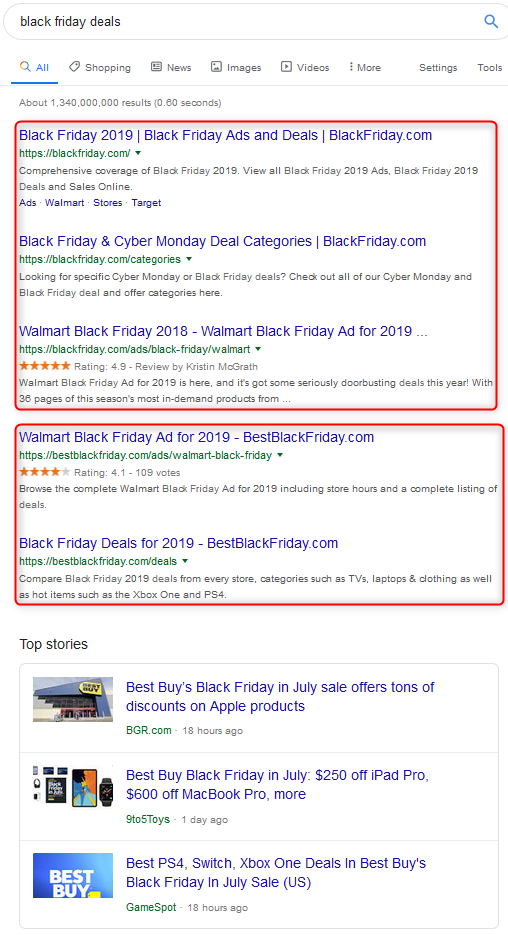
As you can see blackfriday.com still takes up the first 3 organic positions and bestblackfriday.com takes up the next 2 spots. The articles that appear in the Top Stories feature are diverse, but again this is likely entirely due to the date.
Example 2: March Madness
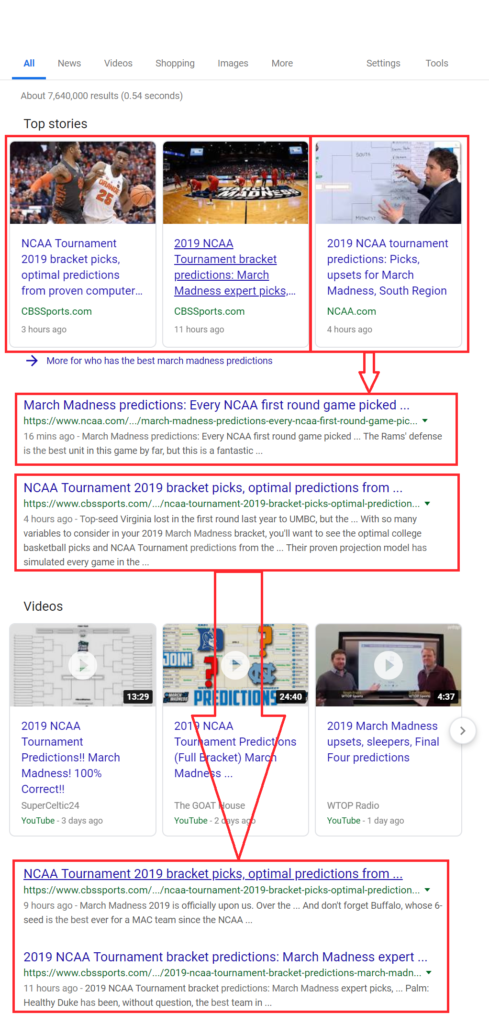
If we exclude Google’s video carousel, we get similar results to the previous example. Specifically, 2 websites – cbssports.com and ncaa.com – claimed the first 7 results.
As in the first example, the articles that showed up in Top Stories are included in the organic results. In fact, 3 of cbssports.com’s articles appear to be the same article, though they each have slightly different time-stamps. Not only is this wildly confusing for users, it is even more so for SEO’s.
To be fair, Google engineers may have good reasons to show multiple results from the same website consecutively. However, in the context of this article, it can create a bad user experience.
Some of you may have noticed that both of the queries for the first 2 examples were conducted the day before the big events. If I stopped here, it would be reasonable to assume that there is just something funky going on with the part of Google’s algorithm that deals with freshness.
However, that’s not the case.
August 2019 Update:
Similar to the first example we can’t fully analyze the impact for this query until March Madness rolls back around.
After searching for “who has the best march madness predictions” the given results do appear to adhere to Google’s diversity update.
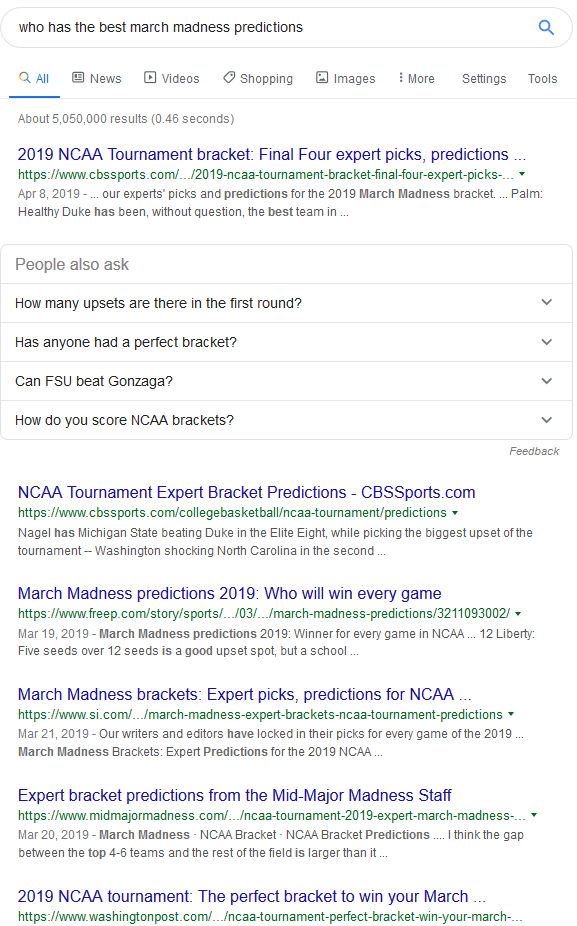
The diversity update appears to have had a pretty big impact here. Only 2 sites show up with more than 1 placement, and each of those only appears twice.
Example 3: Legal Directory Search Results
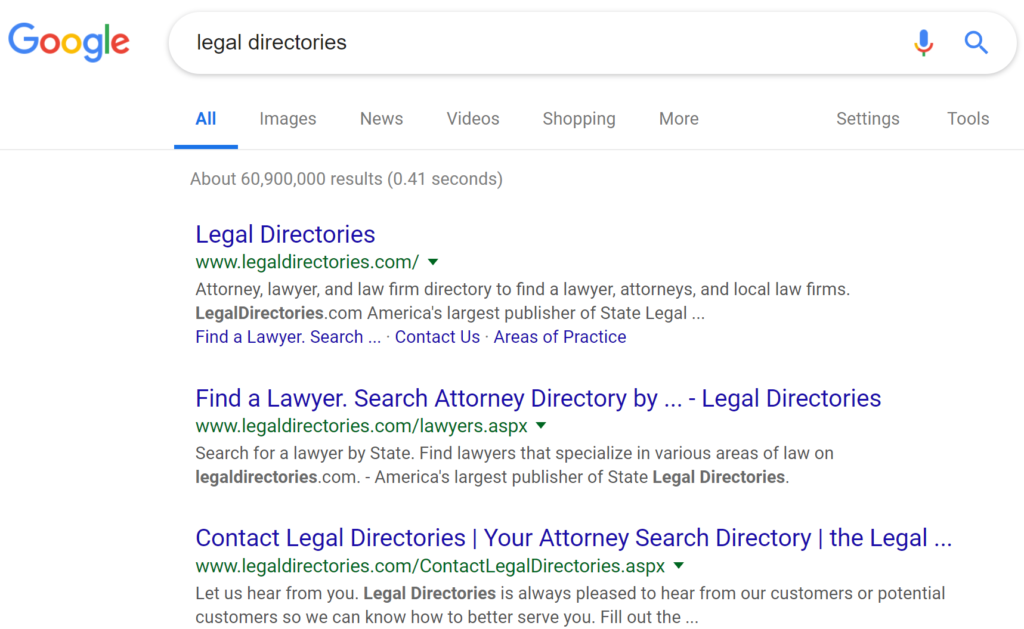
As the SEO Director at Postali, I work in the legal industry and many of my examples are law-related.
In the example above, I was looking for a list of legal directories where I could create profiles for my clients that would help them gain exposure and generate leads.
Interestingly, Google’s algorithm concluded my intention was to find an exact match brand www.legaldirectories.com when my intention was to find a list of directories.
This example is importantly different than the others I’ve listed, since Google’s algorithm didn’t understand my intent. However, it’s relevant nonetheless.
August 2019 Update:
The diversity update also appears to have impacted this example. Google only displays www.legaldirectories.com twice for this query which aligns with their statement on the update. No other site shows up more than once.
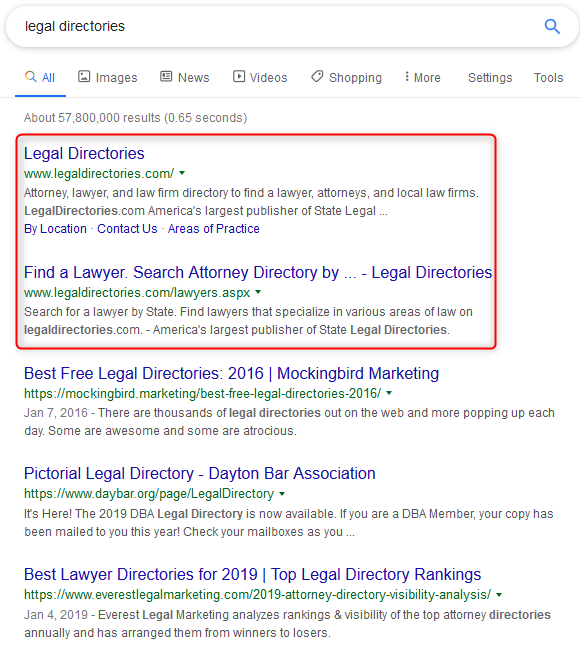
Example 4: Las Vegas Car Accident Lawyer
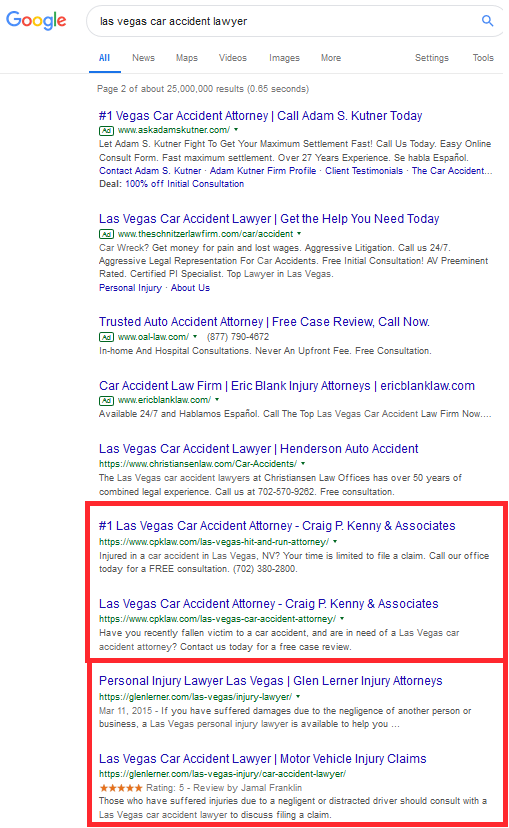
If a user is searching for “Las Vegas car accident lawyer” they likely want to identify and evaluate their options.
To some extent, Google is limiting users’ options by giving 2 law firms back-to-back placements.
Still, the most interesting part is that it doesn’t really matter which page you visit for either of the law firms. The 2 pages each accomplish the same goal.
August 2019 Update:
Both websites in this example only showed up twice each, and with Google saying the diversity update will only impact query’s that display 3 or more times organically this example may not have been impacted.
However, the SERP for this query changed but likely not due to the diversity update.
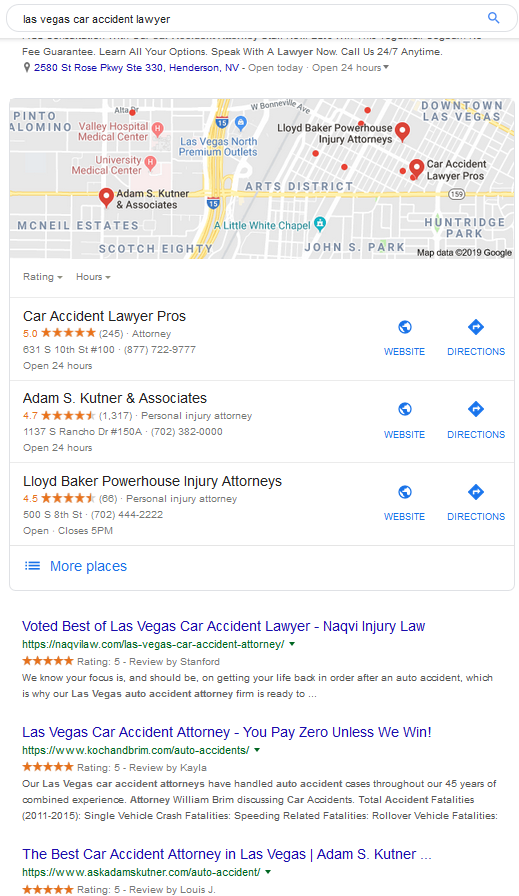
Now, neither of the sites have multiple placements. Additionally, none of the websites displayed have multiple placements.
Example 5: Sandusky Criminal Defense Attorney
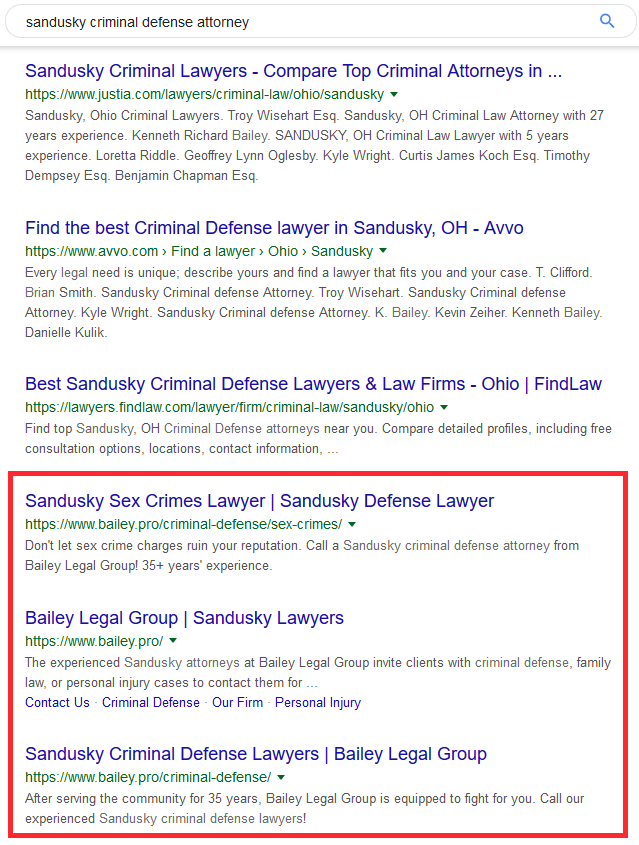
This example appears further down the page than the others, but it is still on the first page.
It is important to note that Sandusky, Ohio is not a large city, but it’s large enough that there are plenty of other criminal defense attorneys Google could have displayed.
August 2019 Update:
As you’ll see, the diversity update also had an impact on this query. Google no longer displays 3 results for any particular website. Further, only one website www.ohattorneys.com shows up more than once with back to back placements.

Example 6: Washington D.C. Car Accident Lawyer
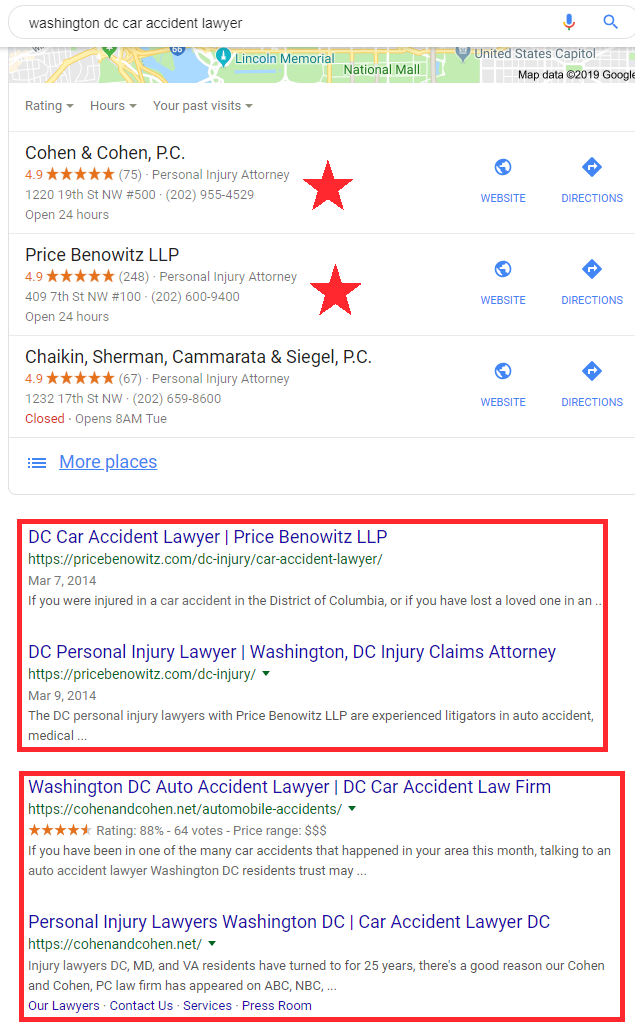
This example involves both Google My Business (GMB) and Google organic search results.
It is another instance of Google limiting users’ choices – that is, unless they are motivated or take the initiative to go beyond the first page.
The SEO joke that “The best place to hide a dead body is on page two of Google” works well here.
For this query, users are shown just 3 options in the first 7 non-paid results (when the 3-pack is included). Two of the options take up 6 of the top 7 results.
Given these considerations, I can’t help but recall that, in 2016, Google’s Possum update prevented individual businesses from dominating the local pack.
Is it time for Google’s organic search team to follow suit?
August 2019 Update:
Google’s diversity update shouldn’t have an impact on this query. The update only impacts organic results and doesn’t take in to account local listings in the 3-pack.
However, the results are different. Price Benowitz LLC, no longer shows up twice in organic results, but I doubt they’re too upset. They show up first in the 3-pack and first organically so it’s unlikely they’ve noticed any negative impact at all.
Cohen & Cohen still have back to back placements organically on top of showing up in Google’s 3-pack.
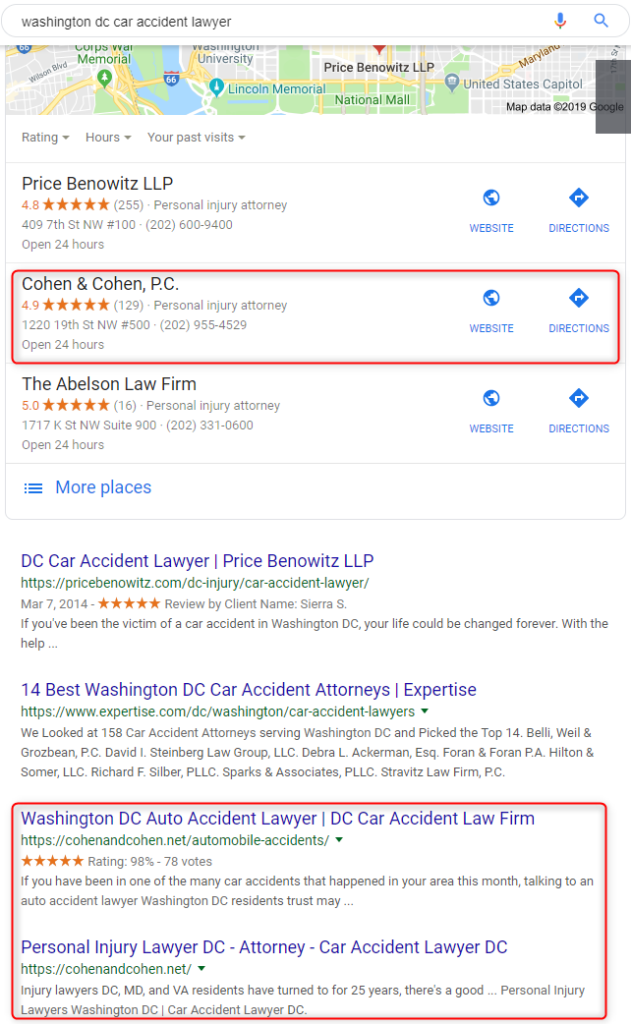
Example 7: Miami Car Accident Lawyer Mobile Results
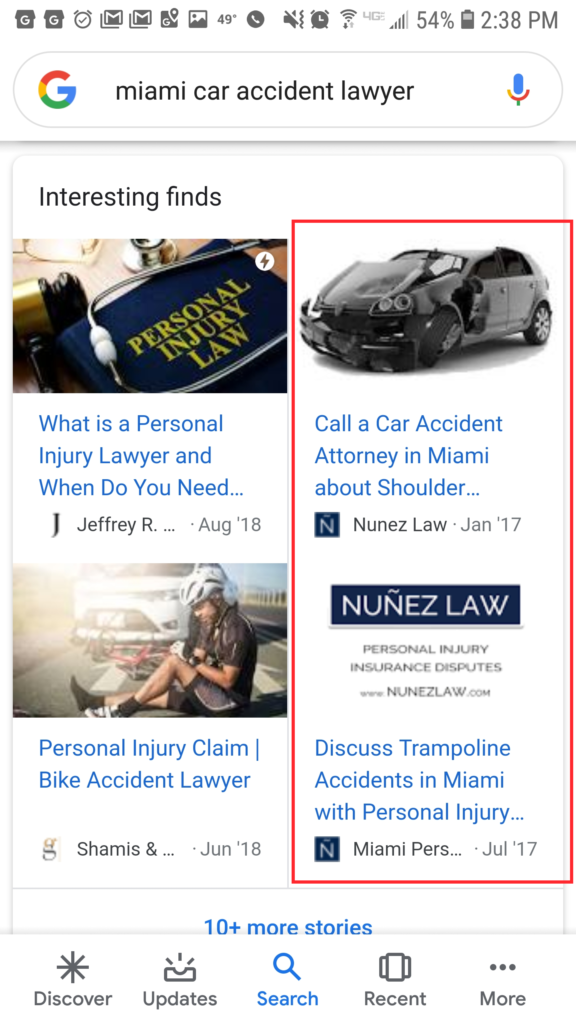
Google’s Interesting Finds mobile SERP appears to have the same issues as the organic.
Not only does 1 website claim 2 of the 4 positions, but 1 of their 2 articles is also completely irrelevant. If someone is searching for a car accident lawyer why would they be shown an article about trampoline accidents?
August 2019 Update:
Again, the diversity update shouldn’t have had any impact on this query. And while the results have changed it’s unlikely due to the diversity update.
The Interesting Finds panel doesn’t display more than one result for any given website. Nunez Law still has an article in the panel, but ironically it’s the completely irrelevant trampoline accident article.
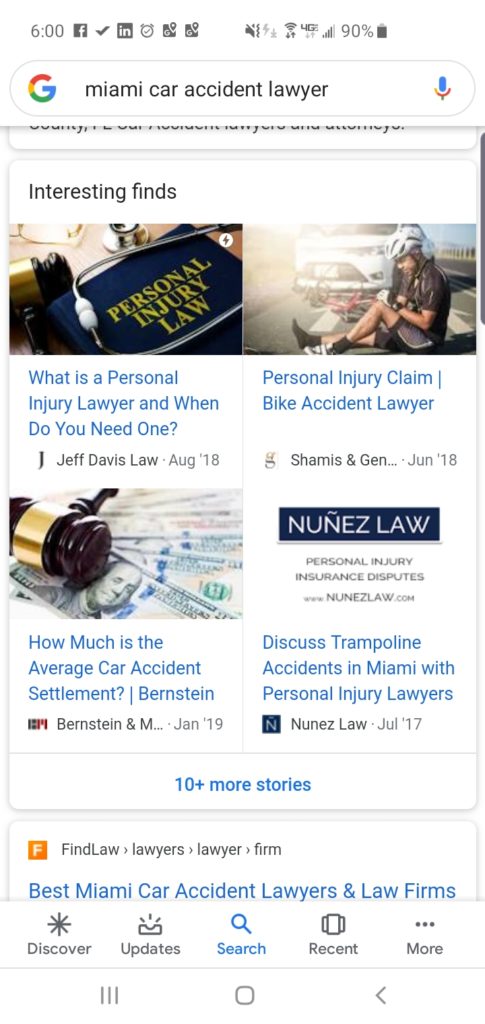
Example 8: Car Lease Mobile Results
Below is another example of the Interesting Finds SERP feature, with 2 of the 4 results coming from 1 website:
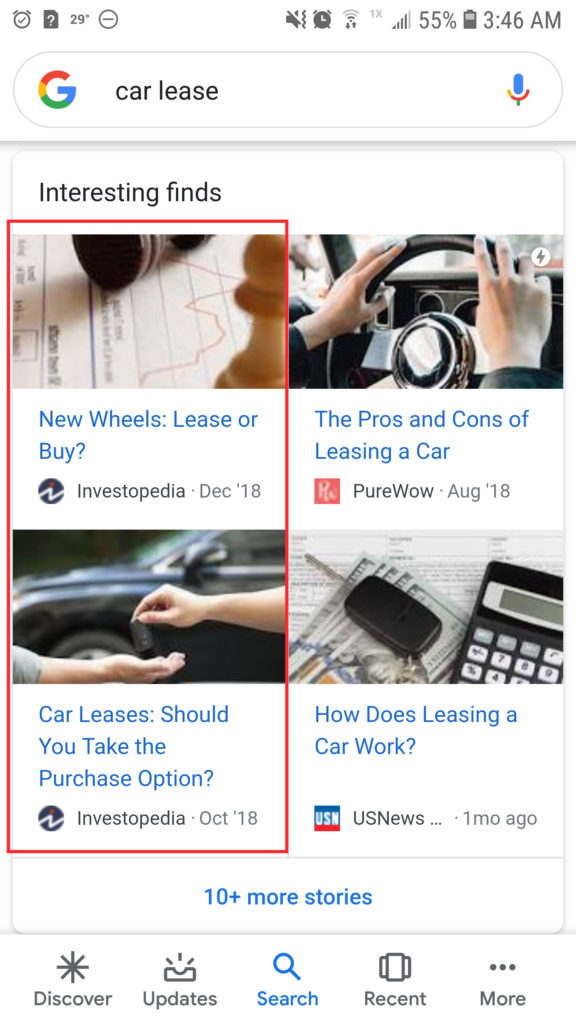
The two articles cover slightly different topics, but are they really the two best options?
August 2019 Update:
Similar to my last example, Google doesn’t return multiple results for any 1 website. With only 2 mobile Interesting Finds examples we can’t say whether or not the diversity update had any impact here.
Google hasn’t specifically said whether the diversity update had any impact on the Interesting Finds panel. However, from their blog post mentioned above, it’s unlikely to have impacted these panels.
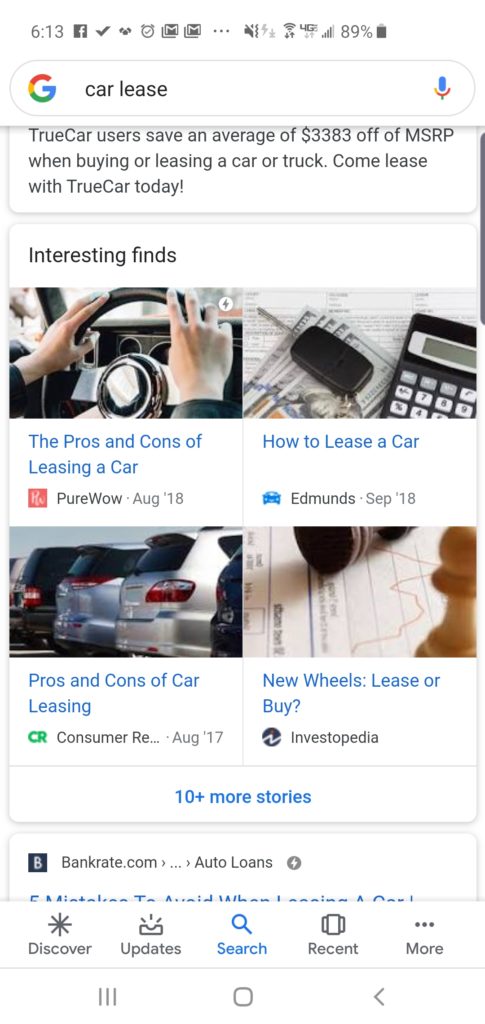
Example 9: Disavow Research
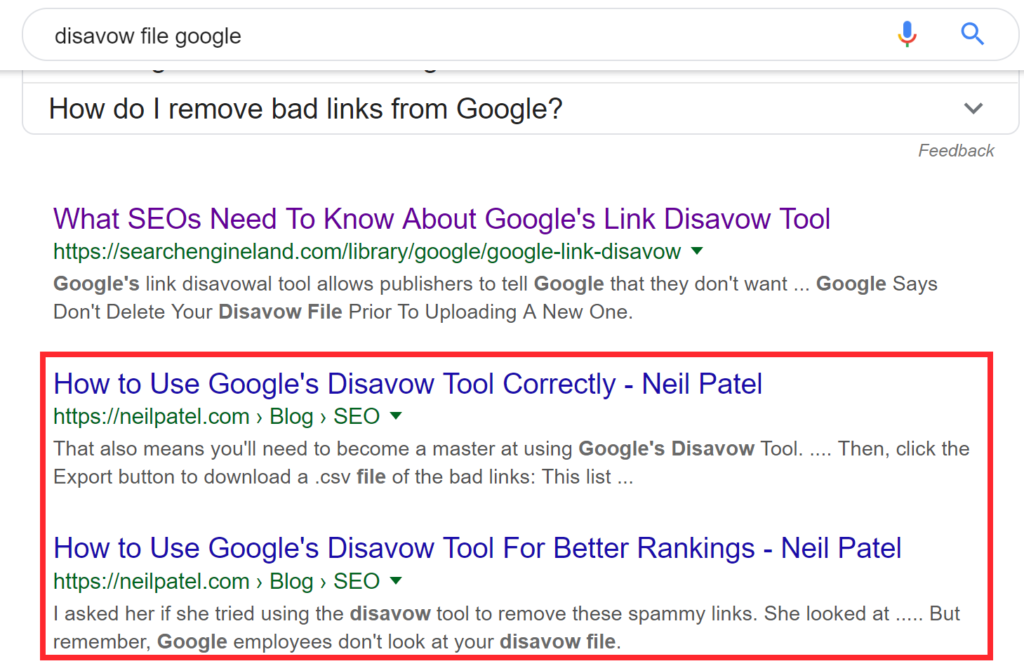
While the content may be different in the 2 articles authored by Neil Patel, they essentially contain the same message.
With countless articles on how to best use Google’s disavow tool, I imagine several provide more unique value than one of those listed.
August 2019 Update:
Similar to previous examples this query should not have been impacted due to the diversity update.
Currently, Google only displays 1 result from Niel Patel’s website. Though, there are a few possibilities as to why. Since the content on each of the 2 Niel Patel pages is substantially similar, Google may have automatically selected a canonical tag. Additionally, it’s possible Google’s other updates had an impact.
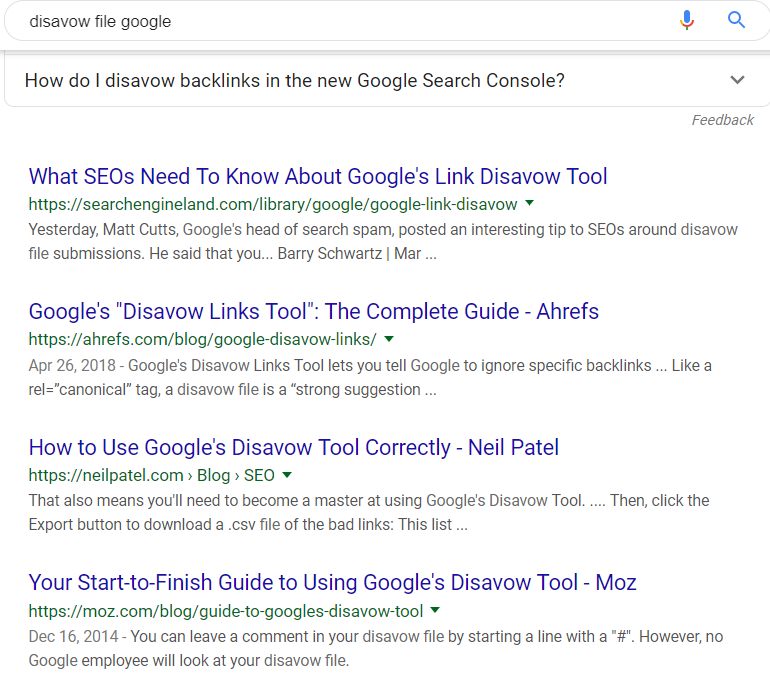
Example 10: DUI Lawyer Search Results in Columbus, OH
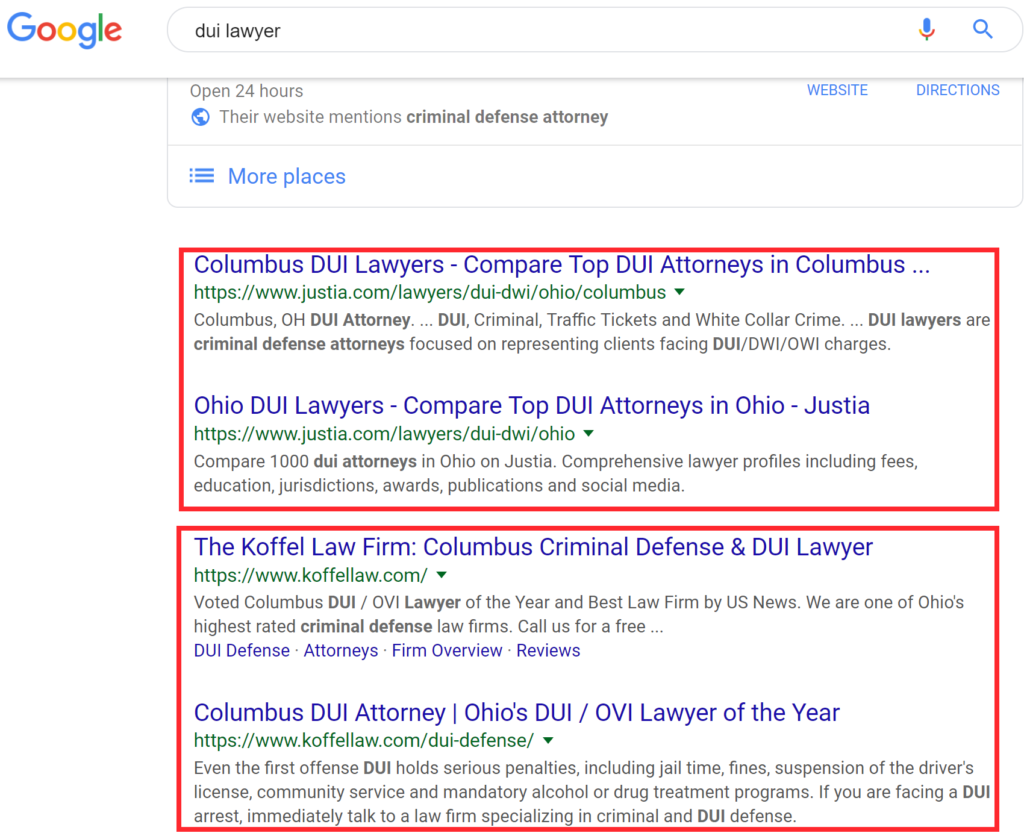
Here’s another great example: Google showed the top-level category page and the page that more closely matched my search intent.
Since I am based in Columbus, it makes sense for Google to show results that align with my search location.
That being said, either of the results from both websites would have satisfied my search query.
August 2019 Update:
Google’s diversity update shouldn’t have had an impact on this search query since no website had more than 2 SERP positions.
Interestingly, Google no longer shows more than 1 result from any particular website. If you take what Google said about the diversity update at face value it would mean this change was due to a separate update.
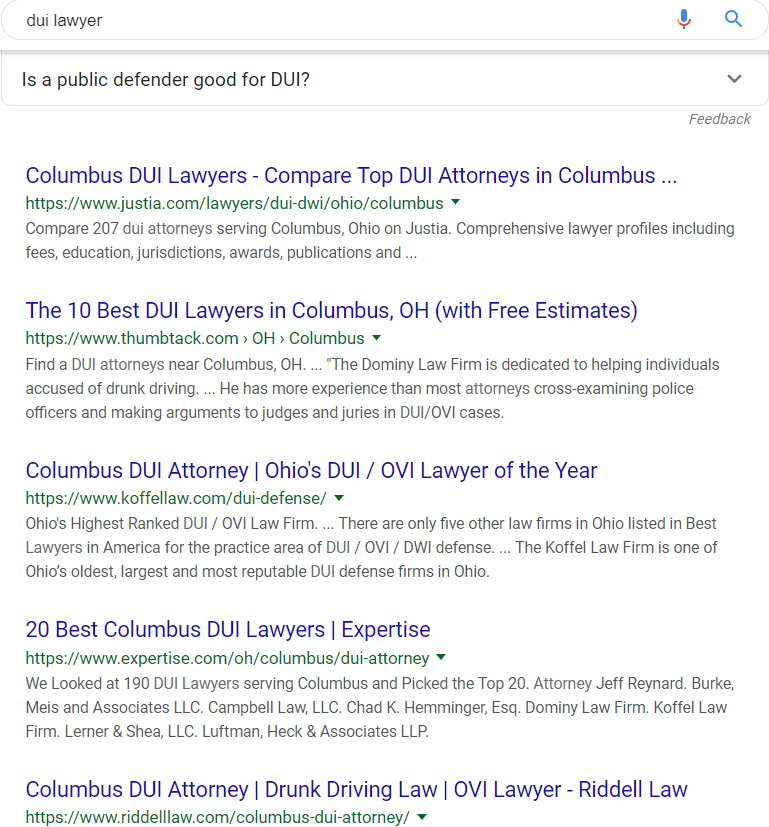
Example 11: Car Accident Lawyer search results in Miami, FL
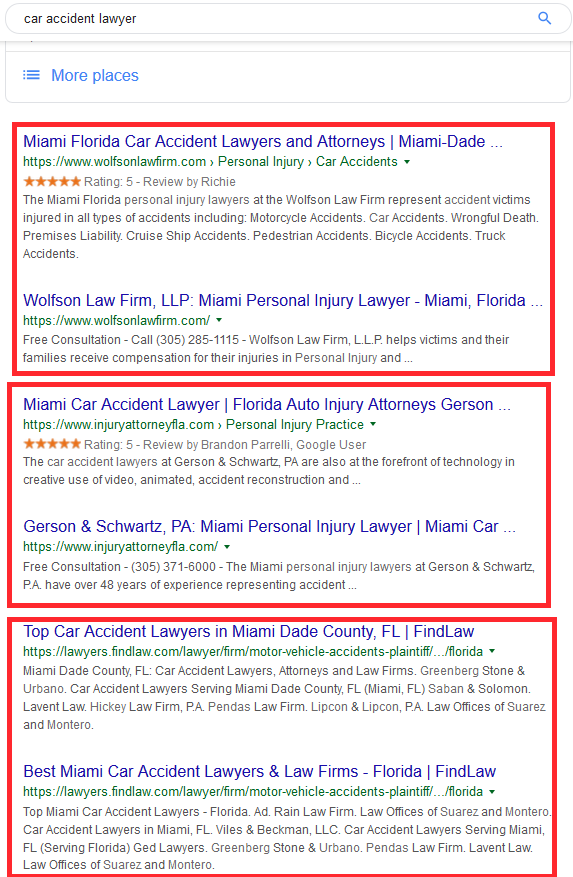
This is probably the most straight forward example. It perfectly shows what’s happening.

In this case, Google is showing both the parent theme page and the page that better matches my search intent.
Maybe this is just a case of “growing pains,” while Google algorithms get better at understanding related themes and users’ intentions.
August 2019 Update:
After the update, only 1 website shows up twice in this example. When looking at this example in tandem with the others I’m starting to see a new pattern.
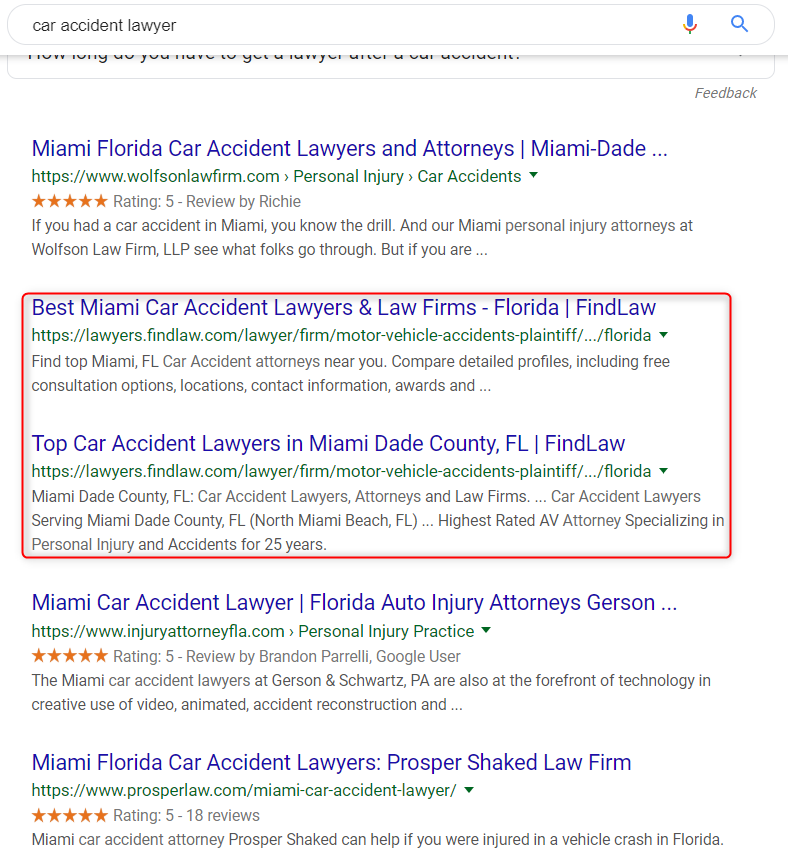
It’s starting to look like Google’s diversity update may impact a wider range of scenarios than previously let on.
Google is only allowing 1 website to have more than a single position in organic SERPs in 11 of the 12 examples.
Example 12: Rejection Letter
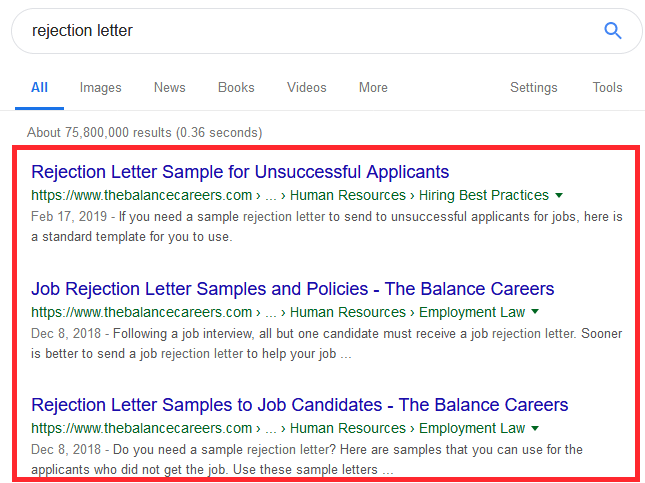
Out of 75,800,000 results, the top 3 positions are filled by the same website. Like many of the other examples I’ve raised here, these articles contain the same message.
August 2019 Update:
Interestingly, the results for this query are largely unchanged. Google still returns 3 results from The Balance Careers even though this search term is clearly non-branded and the content on each of the 3 pages is equally similar to one another.
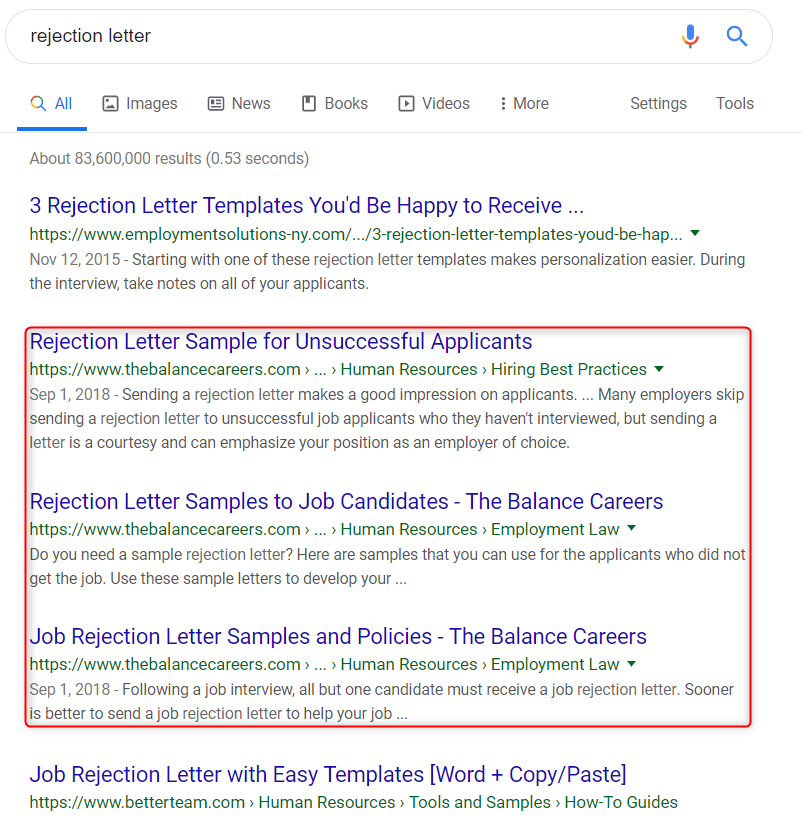
Example 13: Recent Twitter Find
(thanks for a reply)This is Not a Honeymoon Boost @Marie_Haynes this looks like something fishy they were doing, Bcz for very High Competitive k.w’s They ranking for 3 months for top Positions & also with 2 URLs they created for every topic & 2 URL’s are Ranking. pic.twitter.com/4PxEwFGwbg
— Ananth RP (@rp_ananth) April 30, 2019
This is a recent example I found on Twitter. It’s unique in that it’s a relatively new website that doesn’t appear to have many quality backlinks or offer unique value.
Quite simply, it looks like every other generic coupon affiliate website. Why is this site even ranking at all, let alone taking up 2 of the top spots?
August 2019 Update:
I can’t replicate the variables (such as location) for this search query since this example was found externally.
However, when using the same search term not a single site shows up more than once. Additionally, the example website shown above doesn’t show up on the first page at all.
Conclusion
There seems to be something odd going on with how Google algorithms are displaying pages based on users’ search intentions.
Each of these examples demonstrates that Google is (sometimes) unable to decipher which webpage most accurately responds to a user’s search query.
So, instead of picking the 1 it thinks is the best, it displays multiple.
On January 2, 2019, I tweeted a couple of these examples to Google’s Senior Webmaster Trends Analyst, John Mueller and Google’s Search Liaison, Danny Sullivan.
@JohnMu @dannysullivan There have seemingly been a ton more same-site consecutive results since August for non-branded quires. This can’t be a good user experience. Have you noticed the same? pic.twitter.com/l0uYOx80R6
— Dan Foland (@DanFoland) January 3, 2019
Danny Sullivan responded by saying he would pass it on.
Thanks. I’ll pass this on.
— Danny Sullivan (@dannysullivan) January 3, 2019
From what I’ve seen, this matter doesn’t appear to affect the majority of searches, but it’s happening enough to be noticeable.
If you have examples of similar results I’d love to see them. Feel free to drop them in the comment section below or send me a tweet at @DanFoland.
August 2019 Update Conclusion:
Google’s diversity update announced on June 6th, 2019 appears to have had a large impact on Google’s search results.
Most of the original examples in this blog post didn’t fit with what Google said about its diversity update. As previously mentioned, Google said the update would only impact search results that returned more than 2 results for any particular website.
If we only look at the 13 examples in this blog post and ignore Google’s other algorithm updates it would appear that the diversity update had a wider impact than let on.
In 12 of the 13 search queries, only 1 of them returned more than 1 result from any given website.
Google’s site diversity update may have (sometimes)limited same-site results to 2 per website but it also appears to have limited SERPs that were dominated by only 2 or 3 websites.
Case Study Flaws
- The diversity update was only looked at in a vacuum-. Google has launched multiple algorithm updates since first collecting examples almost 9 months ago. It’s impossible to know how much the diversity update impacted each of the examples.
- Sample size– Google receives roughly 6 billion searches each day, a much larger study is needed to gain more accurate insights.
- Consistency in variables– Most of the searches were done at the same location, using the same browser, and related to the legal field. To accurately measure the impact of the update there needs to be hundreds or thousands of more variables.